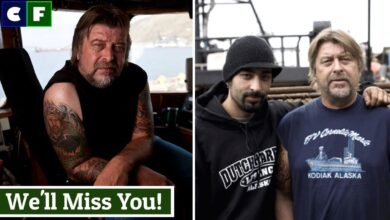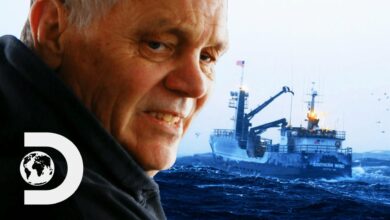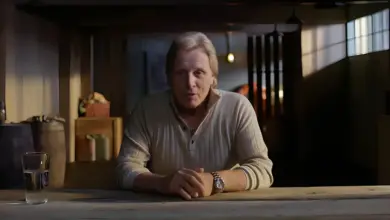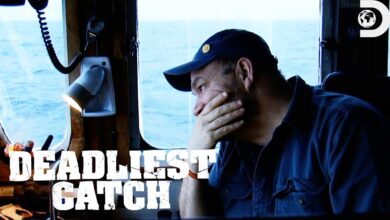What They Just Caught On Deadliest Catch SHOCKS Everybody!
What They Just Caught On Deadliest Catch SHOCKS Everybody!

The Deadliest Catch
This has to be the deadliest catch on the show. What the cameras captured during that storm was so terrifying that it made hardened fishermen shake to their bones. Why did they have to immediately go back to shore? Let’s explore one of the weirdest deep ocean creatures no one has ever seen.
Dangerous Path of False Pass
The boat is heading 260 miles northeast of Dutch Harbor to finish off the King crab season. The captain, Jonathan Hillstrand, seems more upbeat than usual, as this is their fourth outing this season. He’s quite pleased with their catch so far, which includes numbers in the forties and fifties. The whole crew shares his excitement, even though some folks jokingly call them ‘short-timers.’ If Jonathan can navigate through this final challenge, they’ll be on their way home.
These guys, each about 45 years old, are seasoned enough to handle whatever the sea throws at them. Soon, they’re pulling up their crab pots filled with the crabs they’ve been chasing, and they even catch a rogue crab trying to escape.
All season long, they’ve been placing their pots in some well-kept spots in the ocean, and it’s been paying off big time. Jonathan is particularly happy about one pot that’s overflowing with crabs, calling it a ‘sweet spot.’ Meanwhile, Steven is thrilled about finishing up soon because this big catch means they can head back earlier than planned. Suddenly, their gear gets caught up with another boat’s equipment. Mike notices right away, and there’s no time to waste figuring out whose gear it is or where the other boat is. They just need to get untangled without damaging their own gear. They manage to avoid a major mess and breathe a sigh of relief because the last thing anyone wants is to dive into freezing water to cut away tangled lines. With only 13 pots left and a storm breathing down their necks, they need to fill up their storage fast.
The crew is anxious about what they’ll find in the remaining pots; there’s always a chance they could be empty. After a long and tiring season at sea, they decide it’s time to wrap up. Luckily, it seems fortune is on their side. They finish the season with a couple of pots they didn’t get to check, and now they’re racing against the storm, trying to get through False Pass—a notoriously narrow and dangerous path. This channel can whip up 30-foot waves that could easily crush their boat. But they have no choice but to push through if they want to get home safely.
False Pass itself is a tiny spot on Unimak Island in southwest Alaska with a small population of 397 people, most of whom are seasonal workers at the local fish plant, though only about 35 people live there year-round. This place was named by early American captains who mistakenly thought their large ships couldn’t pass through the northern end of what is now called the Isanotski Strait. It officially became a community in 1921 when a post office was established, building on the foundation of a salmon cannery set up a couple of years earlier.
In False Pass, fishing is more than just a job; it’s what keeps the community ticking. They fish for halibut, salmon, cod, and those expensive crabs. Living on the edge of the Aleutian Islands, right by the Bering Sea, these folks know all too well how fine the line can be between a bumper catch and coming home empty-handed. Did they make their million-dollar goal this season? Only the sea has the answer, and it’s not one to share its information lightly.
On the ship, now 190 miles northwest of Dutch Harbor, the crew faces off against strong winds and giant waves near the Pribilof Islands. They understand that respecting the ocean is key to surviving out here. Jonathan hopes for smooth sailing as they continue to delve deeper into the fishing grounds. From 180 fathoms to beyond 5,400, his goal is to haul in between 4,000 and 5,000 pounds of crabs, dreaming of hitting that million-dollar mark.
Captain Jonathan Hillstrand steers through a 200-mile-wide storm, battling the ocean for a record-breaking 50,000-pound golden king crab catch in towering 25-foot waves. They finally find the perfect depth and, to their surprise, pull up huge, bright red crabs that add substantial weight to their pots. With storms brewing and their pots nearly full, the Time Bandits face more challenges. Will the ocean keep rewarding their hard work with plenty of crabs?
Hunting Golden King Crabs
King crabs are a major part of their catch, known for their large size and tasty meat. These crabs, thought to have evolved from hermit crabs, showcase the incredible adaptability of sea creatures, thriving in the cold depths of the Bering Sea and beyond. These crabs are not only a testament to the diversity of marine life but also a prized catch that brings significant rewards each season.
Crab fishing might sound like an adventurous outing, but it’s more akin to a high-risk bet where the dangers are real and the stakes are high. Take horseshoe crabs, also called king crabs, for instance. Their life starts anew each spring when the eggs from the previous year hatch. Before these crabs can mate, they have to shed their old shell in a process called molting. The female crabs then carry the eggs on the outside of their bodies for nearly a year, timing the hatching with the spring’s plankton surge, which serves as food for the newborns. These tiny crabs go through several growth stages, transforming from one form to another, gradually taking on the appearance and characteristics of adults. Initially, these younger crabs stick to shallow waters, but as they age, they venture into deeper waters to lay their eggs, only to return to the shallows yearly until their life cycle, which can last up to 30 years, ends.
Now, let’s look closer at the situation with these crabs. The Alaska Department of Fish and Game might claim that red king crabs are doing okay, but the fuller picture is less optimistic. Many of the crab stocks in Alaska are declining, leading to restrictions or complete halts in fishing to prevent further decline. There are some areas where fishing is still allowed under strict limits to ensure sustainability, but overall, it’s clear that Alaska’s crab populations are not what they used to be. These crabs naturally go through cycles of boom and bust, heavily influenced by their environment, which means fishing has to be carefully managed to avoid depleting the stocks. Keeping a close watch and adjusting fishing practices based on population changes is key to sustainable management. Back in 2011, this industry hauled in 17 million pounds of red king crabs, worth over $110 million, showing just how valuable this fishery is.
Genetic research adds another layer to our understanding of these creatures, revealing that red king crabs and hermit crabs are surprisingly close relatives. This is evident in their asymmetric claws; they use the smaller claw for tearing food and the larger for crushing. Alaska’s waters also host other, less common types of king crabs, such as blue, golden, and scarlet.
In a fascinating display of natural defense, king crabs gather into what are called pods, stacking on top of each other to form a barrier against predators. These pods can grow quite large, stacking thousands of crabs into towering formations.
Focusing on the human element, Captain Jonathan and his crew are continuously chasing the perfect conditions under which king crabs thrive. It’s not just about dropping nets; it’s about understanding the ocean’s depths and finding the right spots where crabs are likely to be. With costly equipment on the line, each decision to move to a new location is fraught with financial risk. At times, the captain decides to take a gamble on spots where he believes a bounty of crabs can be found, even if it means navigating challenging waters and risking expensive gear.
As the captain ventures to a 400-fathom ridge, he’s driven by the prospect of striking it rich with golden king crabs. Battling against strong winds and rough seas, the sight of large crabs boosts the crew’s morale, affirming the captain’s hunch. However, the work is tough, and maintaining safety becomes a critical concern as they maneuver through treacherous conditions. The crew must think strategically, constantly adjusting their plans like players in a complex game of chess, adapting to the unpredictable ocean. With a full load and a storm close behind, the crew must navigate the dangerous passage of False Pass. Their way home is anything but certain.
Teamwork in Rough Seas
On some days, the ocean is generous, rewarding the crew with catches worth nearly a million dollars. But not every day is a win; there are times when the nets come up empty or filled with unwanted debris, highlighting the fickle nature of crab fishing. It’s a business where huge rewards can be followed by significant losses, mirroring the unpredictability of the ocean itself.
The economic aspects of crab fishing are complex. Operating the specialized equipment necessary for catching and processing crabs, such as traps and pots, requires skilled labor, which doesn’t come cheap. Moreover, once the crabs are caught, they need to be manually cleaned and processed, adding to the overall cost of production. The scarcity of crabs adds another layer of complication. Unlike some other seafood that can be farmed, crabs are caught wild, which means their availability is dependent on natural populations that can fluctuate with environmental conditions like water temperature and quality.
Despite these challenges, the demand for crab meat remains high. Many people consider it a delicacy, and its unique flavor and texture make it highly sought after in the culinary world. This high demand, combined with the expensive and labor-intensive process of catching and preparing crabs, results in high prices for crab meat.
The deep-sea crab fishery is an intricate and demanding industry, requiring both skill and luck. It’s a high-stakes endeavor where crews brave the elements to harvest a valuable resource, balancing risks and rewards in a constantly shifting environment.





